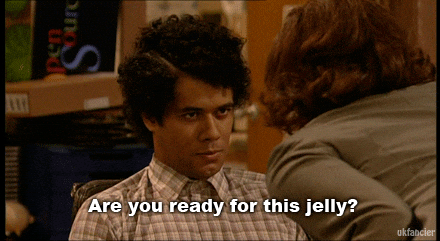What is CX? When is CX? Where is CX? Who is CX? How is CX? Why is CX? Stick around, we're going to be answering all your questions on CX. I mean probably not 'How is CX', because that doesn't even make any sense. Come on.

CX is basically all about identifying the ingredients to success. It's a little bit of customer trust, a pinch of user interface, a dash of user experience, a tablespoon of KPIs, with a data analysis mist. And viola, you've got yourself a full plate.
But why measure CX? Well, why measure anything? Measurement is the foundation of everything, according to Thanassis Thomopoulos, Head of Global Marketing & Commercial Analytics at eBay. Nothing can really be improved without measuring them first.
Thanassis gave us a quick explanation for the evolution of business KPIs and how they've evolved, in his #MarTechFest Dial Up (Mini) websesh .
He started with revenue, or margin (and always some kind of combination of the both), it was then suggested that these are too concrete and too hard as KPIs. Instead, marketers need to move to metrics which indicate higher aspiration, such as brand love. After all, it's seven times more expensive to acquire customers than to retain them.
Then what happened? Well, in most businesses, this brand loyalty began to decrease in terms of effect, to the benefit of CX. If you have customers who have loyalty to the brand, but are constantly bombarded with poor customer experience, they will eventually churn away to your competitors.
So, CX is the ultimate thing you need to measure.
What is CX?
Customer experience basically refers to how a business engages with its customers at every point in their buying journey.
This includes marketing, customer service, sales and more. It's the sum total of every interaction your customer has with your brand. Every touchpoint is vital as it can make or break the entire experience.
More and more, consumers have begun to differentiate between brands not based on the specific product features and functions, but the experience of the company.
Why has Netflix taken over Blockbuster? Both are basically peddling the same business model, right? But when customers think about Netflix they think convenience, and barely about the product they arrived there for - the movies themselves.

You should really think about CX as a series of customer journeys. One for awareness, one for onboarding, one for continued renewal, and even one for leaving. This is because customer journeys are the sum of your client's interactions with your brand.
So, how do you measure how effective your customer experience is? Well, you could start with something simple, talking to your customers.
1. Ask your Customers
I know this sounds overly basic. But it's 2021, and nowadays it's all about healthy and productive communication.
Something like a customer satisfaction survey is a super easy way to figure out how your customers are doing, as well as helping you to:
- Gain valuable feedback
- Identify trends
- Reduce negative word of mouth
- Find areas for improvement
- Understand your customers
Also, with a survey, you aren't waiting for your customer to approach you. Instead, you're clearly making an effort to keep in touch with them, and tackle any potential pain points or complaints.
You might even use Net Promoter Score, or NPS. This is a customer loyalty and satisfaction measurement, taken from customers, asking how likely they are to recommend your brand to a friend.

NPS can be used as a predictor of business growth, as well as revealing whether you have a healthy relationship with customers.
A high NPS means a positive growth cycle. Although the score alone is not enough to paint a complete picture, it can provide a method for asking more detailed follow-up questions, tracking and quantifying the score over time to create internal benchmarks, or even to rally employees around creating happier customers in a tangible way.
2. Carefully Observe your Customers
Digital businesses can measure everything at a scale, so the question becomes "what am I going to measure, and what am I even going to do with the data?"
Firstly, measurement tagging is crucial. In data analytics, a tag is an element included on each webpage to be measured, which allows the third-party analytics tool to long connections on its server. Tags often collect some info about the visitor on your site, and how they behave. Useful stuff.

Second, compliance matters. You've got to stay on top of changes. It's not just about staying within the law, which is of course important, but about creating and maintaining trust from your client.
Don't just go as far as you can, playing fast and loose with GDPR. If your privacy rules meet the standards of the law, but not your customer, you can destroy the relationship.
Measure CX on the behavioural side. There are quite a few behavioural metrics you can use, including:
- Task Success Rate - i.e. how many users are starting, and finishing, the forms.
- Time on Task - i.e. how long did the form take, and how painful it was. Length of time can often be directly related to the amount of pain caused.
- User Error Rates - i.e. how many customers started and abandoned the form, and how many failed. This could be putting in the wrong phone number, putting a postcode in the wrong box etc. etc.
Measure CX using business KPIs. Many businesses like to track customer lifetime value, which is not easy to measure.
When do you stop measuring? Are you predicting how long a customer will live? Are you a scary fortune teller in a spooky circus tent? No? Well, an alternative is to try what other businesses are shifting to, customer annual value.
Basically, it is the value of one customer journey, multiplied by the number of customer journeys. One customer journey has a certain value, and then additional values can be added to it, such as upsells and cross sells.

So how do you balance both? They can be conflicting. You want to be providing seamless experiences for your customers. They expect it. But on the other hand, you want revenue.
The standard way to do so, would be to advertise and monetise your inventory. But people don't hate ads, they hate bad ads. And they especially hate a lot of ads. So, with a little bit of advertising, you'll get a little bit of revenue back, even if customers don't complete the transaction.
With a lot of ads, you might get a lot of revenue, but the effect on CX or UX might be significant. You need to find the right balance.
3. Know your Customers.
So, who can you go one step further, once you have all these data points?
Well, it's about knowing your customers. The question is, how can you get the most out of your best customers?
You can measure, and create differentiated experiences if you know about the customer when they log in. This includes age, preferences, location, device type used, even if they move between devices, e.g. moving from their laptop to their phone to complete a transaction.
Paying attention to these details is important, as this is what customers value in terms of experience.
Experiences sometimes need to be different for different people. Some people want details of their purchases to be reassured, others are all focused on the need for speed. CX is very personal, so it needs to be personalised. Different strokes for different folks, and all that.

But remember, once again, that when it comes to knowing customers and handling data, trust is all important. You must be spotless in how you share, or don't share, customer data.
So, How do you improve CX?
Well, there's a few ways. According to Thanassis, you can:
- Link attitudinal and behavioural data. Basically, you've already created some new insights if you do this. An example of this working is when Netflix asked a focus group what they'd like to see on the signup page, prompting answers of being shown the catalogue, i.e. what they were purchasing.
Instead, what Netflix did was some sneaky A/B testing. This is where the difference between attitudinal and behavioural kicks in - the pages that were inspirational, with a few fields, had a higher sign in rate. - Using Attribution. This is a complicated one. It's all about seeing what credit you give to each touch point. Compare journeys that look the same, and add and remove events, to see what the resulting uplift is.
This all can be outsourced, you'll be glad to know. Basically, it's all about finding out which touchpoint brings the most positive contribution. - Experimentation. CX is not just about user interface or user experience, but the entire experience a customer has. This can be physical, irl stuff, including hotlines, customer service, physical deliveries, deliveries being returned etc.
These are all things that can be experimented with, using A/B testing. In this way, you can fine tune each step of the customer experience, improving CX gradually with each round.
Right, Where do we Start?

Thanassis has a plan for you.Try to:
- Get your measurements in order. This is not always simple. How do you bridge the gap between online and offline? Online is measured, and most people are proficient with it, but offline services like phone calls, invoices and letters also need to be measured. This means having another type of infrastructure or cloud, set up to deal with this issue.
- Build journeys, tie your metrics. Take one framework, start building a few journeys, build a few more sub journeys, then never stop building. Then, tie your metrics to that. Simple as.
- Experiment, and make it personal. Once you've experimented broadly, start then with smaller, more specific, experiments, for more personalised and accurate experiences.
- Repetition, repetition, repetition. Never be happy with a final answer, and always challenge results. It's not about being right or wrong, but about being aligned with the expectations of your customers.
Want to hear more from the very talented, very charismatic, very cool-y named Thanassis Thomopoulos, Head of Global Marketing & Commercial Analytics at eBay? Well, come watch the full websesh on-demand, right 👉here👈. That's right, there👈. Click it. Click it. ☝️
